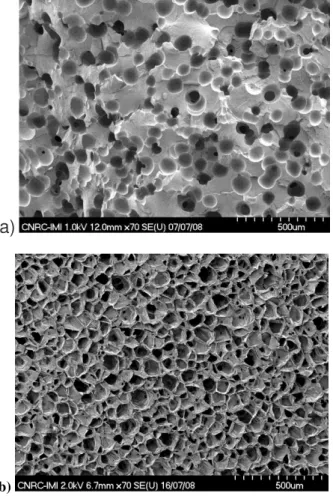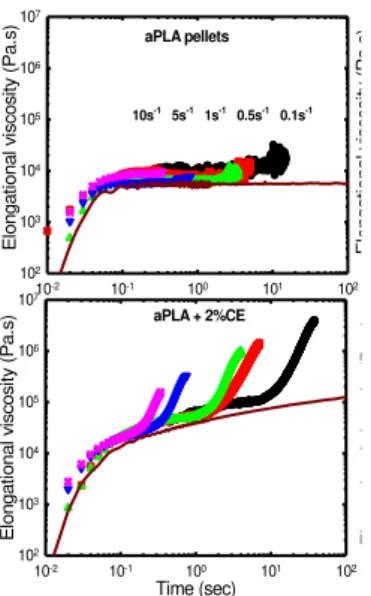Publisher’s version / Version de l'éditeur:
Proceedings of the Polymer Processing Society 26th Annual Meeting-PPS-26,
2010-07-04
READ THESE TERMS AND CONDITIONS CAREFULLY BEFORE USING THIS WEBSITE.
https://nrc-publications.canada.ca/eng/copyright
Vous avez des questions? Nous pouvons vous aider. Pour communiquer directement avec un auteur, consultez la première page de la revue dans laquelle son article a été publié afin de trouver ses coordonnées. Si vous n’arrivez pas à les repérer, communiquez avec nous à PublicationsArchive-ArchivesPublications@nrc-cnrc.gc.ca.
Questions? Contact the NRC Publications Archive team at
PublicationsArchive-ArchivesPublications@nrc-cnrc.gc.ca. If you wish to email the authors directly, please see the first page of the publication for their contact information.
NRC Publications Archive
Archives des publications du CNRC
This publication could be one of several versions: author’s original, accepted manuscript or the publisher’s version. / La version de cette publication peut être l’une des suivantes : la version prépublication de l’auteur, la version acceptée du manuscrit ou la version de l’éditeur.
Access and use of this website and the material on it are subject to the Terms and Conditions set forth at
Understanding PLA crystallization in complex processing operations :
Interrelation between plasticization, chain branching and foaming
Huneault, Michel A.; Mihai, Mihaila; Favis, Basil D.
https://publications-cnrc.canada.ca/fra/droits
L’accès à ce site Web et l’utilisation de son contenu sont assujettis aux conditions présentées dans le site LISEZ CES CONDITIONS ATTENTIVEMENT AVANT D’UTILISER CE SITE WEB.
NRC Publications Record / Notice d'Archives des publications de CNRC:
https://nrc-publications.canada.ca/eng/view/object/?id=2bac11f2-b946-480e-b5b5-775b49a02835 https://publications-cnrc.canada.ca/fra/voir/objet/?id=2bac11f2-b946-480e-b5b5-775b49a02835
Proceedings of the Polymer Processing Society 26th Annual Meeting ~ PPS-26 ~ July 4-8, 2010 Banff (Canada)
UNDERSTANDING PLA CRYSTALLIZATION IN COMPLEX
PROCESSING OPERATIONS: INTERRELATION BETWEEN
PLASTICIZATION, CHAIN BRANCHING AND FOAMING.
Michel A. Huneault1*, Mihaila Mihai2, Basil D. Favis3
1Université de Sherbrooke, Chemical and Biotechnological engineering department, 2500 Boul. de l’Université,
Sherbrooke (Québec) J1K 2R1, Canada; michel.huneault@usherbrooke.ca
2Industrial Materials Institute (NRC), 75 de Mortagne, Boucherville, QC J4B 6Y4; mihaela.mihai@cnrc-nrc.gc.ca
3CREPEC - Chemical Engineering Department, École Polytechnique de Montréal, Qc, Canada; basil.favis@polymtl.ca
Abstract –Pure PLA crystallizes too slowly to develop significant crystallinity upon the rapid cooling typical of most extrusion or injection molding operations. In response to this fact, nucleants and plasticizers can be added to respectively boost the crystalline nucleation density and to improve chain mobility during the crystallization process. Such formulations can be crystallized in injection molds using high mold temperatures and relatively long cycle time. The foaming process is complex from a rheological and crystallization behavior point of view. The viscosity of the polymer increases rapidly due to the phase separation of the blowing agent. Shear forces are substituted by biaxial stresses as the material exits the extrusion die and enters the expansion phase. The crystallization occurs in this complex flow environment where the release of the blowing agent from the polymer drastically changes the Tg and crystallization rate of the polymer. Therefore it is not surprising that strong interactions between the foaming process, foam quality and crystallization behavior were found. This presentation will discuss and review the crystallization behavior of PLA in complex processing operation and will use extrusion foaming as a means to better illustrate this topic.
Introduction
PLA is one of the few biobased compostable materials that are readily available. Foams are often regarded as materials that are difficult to recycle. Because of this, the foaming of PLA has attracted immediate attention for replacement of PS foams. One interesting feature of PLA is that its crystallinity can be controlled by adjusting the content of its two optically active isomers, L-LA and D-LA. The PLLA crystallinity can attain around 45%. This crystallinity level decreases with D-LA content as the D-LA units acts as defects in the PLLA crystals. Therefore, it is possible to control the maximum crystalline level as well as the crystallization rate by playing with the L:D ratio. The crystallization rate can be further modified by adding plasticizer, nucleants (Li et al. 2007) or by adding a second polymer phase (Li et al. 2008). It is also possible to rapidly increase PLA crystallinity levels by subjecting the material to biaxial stresses at a temperature above its Tg (Chapleau et al, 2008). The foaming process is interesting from a PLA crystallization point of view because it combines many features that can promote the crystallization. First, the blowing agent dissolved in the polymer can act as a powerful plasticizer, the extrusion temperatures are typically close the temperature window where the highest crystallization rates are encountered. Biaxial stretching is present during the expension phase and could also lead to crystallinity enhancement. Research on this complex topic has generated very useful knowledge on the crystallization of PLA in processing
conditions and under conditions of large plasticizer concentration. It will be reviewed and compared to results obtained in other processing operations in the presentation.
Experimental
Three different PLA grades, supplied by NatureWorks, were used in this study. Their D-LA content was 2, 4
and 10% (grades 4032D, 2002D and8302D
respectively). A chain-extender (CE), CesaExtend OMAN698493 from Clariant Additive Masterbatches, was used to create branched PLA. It is an epoxy / styrene / acrylic copolymer, provided in masterbatch form in a PLA carrier.
A Leistritz 34 mm co-rotating twin-screw extruder comprising 12 barrel zones was used to prepare the PLA foams. CO2 was used as the blowing agent. It was pumped at mid extruder and solubilised in the polymer. As the blowing agent concentration increased, it was possible to produce the foam at lower extrusion temperature due to Tg depression and viscosity reduction. The extruder was operated at a constant screw rotation speed of 150 rpm. A capillary die with a 2 mm diameter was used to produce foamed rods.
Results and Discussion
Crystallinity control in PLA foams is of primary practical importance to increase heat resistance to acceptable levels. Therefore, the PLA grade must be selected with a sufficient L-LA purity to enable
Proceedings of the Polymer Processing Society 26th Annual Meeting ~ PPS-26 ~ July 4-8, 2010 Banff (Canada)
crystallizable polymers is more challenging because they need to be processed at a higher temperature relative to their glass transition. In the case of PLA, it was also shown to be very sensitive to foam cell rupture leading to a high open-cell content (Mihai et al,
2007) Surprisingly however when foaming
crystallizable PLA grades, best foam morphologies are obtained in a very narrow processing window that lead to simultaneous crystallinity development and foam expansion. For example, Figure 1 and 2 compare foams obtained with at 5 and 9% CO2 content produced at their minimum extrusion foaming temperature (i.e. torque-limited conditions). At 5% content, the viscosity of the material is not sufficiently reduced by the plasticization effect to extrude the material in its crystallization temperature range. The resulting materials are very poorly foamed due to a lack of expansion and gas losses through open cells. At 9% CO2, extrusion temperature can be significantly lowered and the foams are produced in the 100-120oC range where the PLA crystallization rate is maximum. The resulting foams have very low densities and a fully developed crystalline structure. More details on this topic can be found in recently published paper (Mihai et al. 2009)
A second issue with PLA foaming is the rheology. Because of their linear structure and high rigidity, PLA chains cannot entangle as readily as other commonly foamed material leading to a lack of elasticity or melt strength that is detrimental for foam stabilization. This can be corrected through a reactive processing strategy where low molecular weight reactive copolymers are added to branch PLA chains through their acid chain ends. A commercial epoxy-based copolymer was used for this purpose with significant success in terms of rheological modification. This was easily achieved during batch mixing tests where reaction time can be adjusted at will. More importantly however, it was shown that similar extent of reaction could also be obtained during in situ reaction in the extrusion-foaming process. Rheological assessment of the macromolecular structure was obtained through elongational rheometry as shown in Figure 2. A series of blends with different chain extender concentration were produced, characterized in terms of their rheology and foamed. The complete results are reported elsewhere (Mihai et al., 2010). The strain-hardening phenomenon, typical of branched polymer structures was completely absent in pure PLA samples and was clearly accentuated as the reactive modifier content was increased. Surprisingly, this wasn’t accompanied by significant changes in the foaming behavior. This was interpreted as an additional proof of the superseding role of crystallization on the foam cell stabilization. It was also postulated that crystal nuclei formation may slightly precede foam expansion and play an important role on the foam nucleation itself.
The presentation will review and examine these
complex interrelations between crystallinity
development, chemical branching of PLA and rheology and will examine the consequence of these interrelations on the complex and challenging process of making low-density foams. The presented phenomena encompass the technological aspects of foaming since they enable to understand the main challenges and characteristics of PLA processing.
a)
b)
Figure 1 – Morphology of PLA foams. Micrograph a)
shows a material foamed 5% CO2 where no crystallinity development and limited expansion occurred. By contrast, micrograph b) shows a fully expanded and fully cristalline PLA foam produced with 9% CO2.
Proceedings of the Polymer Processing Society 26th Annual Meeting ~ PPS-26 ~ July 4-8, 2010 Banff (Canada) E lo n g a ti o n a l v is c o s it y ( P a .s ) aPLA + 2%CE Time (sec) 10-2 10-1 100 101 102 E lo n g a ti o n a l v is c o s it y ( P a .s ) 102 103 104 105 106 107 10s-1 5s-1 1s-1 0.5s-1 0.1s-1 aPLA pellets 10-2 10-1 100 101 102 E lo n g a ti o n a l v is c o s it y ( P a .s ) 102 103 104 105 106 107 E lo n g a ti o n a l v is c o s it y ( P a .s ) 10s-1 5s-1 1s-1 0.5s-1 0.1s-1
Figure 2. Elongational data obtained without chain-extender (upper graph) and with 2% chain chain-extender (lower graph) for an amorphous PLA grade (8302). Similar strain-hardening was obtained with chain-extended crystallizable PLA grade.
Conclusions
The study of PLA crystallization in the foaming process illustrates well the complexity (and beauty) of the interaction between thermodynamics, rheology and crystallization all interlinked in a single polymer processing operation. The presence of a high plasticizer concentration (i.e. blowing agent) concentration in the polymer, the low extrusion temperature and the potential nucleating effect of CO2 clusters promote
PLA crystalline nucleation prior to die exit and foam expansion. The presence of these crystalline nuclei in turn significantly enhances the foam uniformity and expansion ratio. Complete crystallization can be attained when the conditions above are combined leading to good quality highly crystalline PLA foams.
References
Li H., Huneault M.A., “Effect of Nucleation and Plasticization on the Crystallization of Poly(Lactic Acid)”, Polymer 48, 6855-6866 (2007).
Li H., Huneault M.A., “Crystallization in PLA/Thermoplastic Starch Blends”, International Polymer Processing, 23, 412-418 (2008). Chapleau N., Huneault M. A., H. Li, “TPS/PLA biaxial stretching, International Polymer Processing”, 22, 402-409 (2007).
M. Mihai, M.A. Huneault, B.D. Favis, H. Li, “Extrusion foaming of semi-crystalline PLA and
PLA/thermoplastic starch blends”, Macromolecular
Bioscience, 7(7), 907-920 (2007).
Mihai, M., Huneault, M.A., Favis, B.D., “Crystallinity development in cellular poly(lactic acid) in the presence of supercritical carbon dioxide”, Journal of Applied Polymer Science, 113 (5), 2920-2932 (2009).
Mihai, M., Huneault, M.A., Favis, B.D. “Rheology and
extrusion foaming of chain-branched poly(lactic acid)”, Polymer Engineering and Science, 50 (3), 629-642 (2010).

